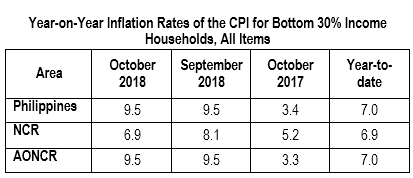OCTOBER 2018
YEAR-ON-YEAR
Philippines

The country’s year-on-year inflation for the bottom 30% income was pegged at 9.5 percent in October 2018, which was the same rate recorded in the previous month. In the same month of the previous year, inflation was posted at 3.4 percent. Compared with their annual increments in September 2018, higher annual rates were posted in the indices of clothing at 2.9 percent; services, 3.5 percent; and miscellaneous, 2.2 percent.
On the other hand, annual mark-ups in the indices of food, beverages and tobacco (FBT) slowed down to 10.7 percent and fuel, light and water (FLW), 9.8 percent. Housing and repairs (H&R) index retained its previous month’s annual rate of 5.1 percent (see Tables 3 and 4).
The annual change of food index at the national level was lower at 9.8 percent in October 2018. Its annual rate was noted at 9.9 percent in the previous month and 3.3 percent in October 2017(see Tables 5 and 7).
Relative to their annual rates in the previous month, annual add-ons in October 2018 were slower in the indices of corn at 5.6 percent; fruits and vegetables, 14.2 percent; and meat, 7.1 percent.
The rest of the food groups registered higher annual hikes during the month (see Table 5).
| Year-on-Year Inflation Rates of the CPI for Bottom 30% Income Households in the Philippines, All Items January 2014 – October 2018 (2000=100) | |||||
|---|---|---|---|---|---|
| Month | Year | ||||
| 2014 | 2015 | 2016 | 2017 | 2018 | |
| January | 5.7 | 3.8 | 1.0 | 2.4 | 4.7 |
| February | 5.7 | 2.9 | 1.0 | 3.0 | 5.4 |
| March | 5.8 | 2.6 | 1.2 | 3.0 | 5.8 |
| April | 6.2 | 2.5 | 1.0 | 2.9 | 6.3 |
| May | 6.7 | 2.1 | 1.1 | 2.6 | 6.4 |
| June | 7.0 | 1.5 | 1.4 | 2.6 | 6.7 |
| July | 7.4 | 0.8 | 1.3 | 2.7 | 7.6r |
| August | 7.1 | 0.4 | 1.3 | 3.0 | 8.3r |
| September | 6.1 | 0.1 | 1.6 | 3.3 | 9.5 |
| October | 6.0 | 0.4 | 1.7 | 3.4 | 9.5 |
| November | 5.3 | 0.9 | 2.0 | 3.4 | |
| December | 4.1 | 1.1 | 2.1 | 3.7 | |
| Average | 6.1 | 1.6 | 1.4 | 3.0 | |
National Capital Region (NCR)
Compared with the level a year ago, prices for this particular group of consumers in NCR exhibited a slower annual increment of 6.9 percent in October 2018. In the previous month, inflation was pegged at 8.1 percent, while in October 2017, the annual rate was observed at 5.2 percent. The slowing down in the annual growth rate of the heavily-weighted FBT index at 6.9 percent primarily contributed to the downtrend. Moreover, a lower annual increase of 13.9 percent was seen in FLW index. On the other hand, compared to its previous month’s annual rate, the miscellaneous index posted a higher annual gain of 2.7 percent this month. The rest of the commodity groups retained their previous month’s rates (see Tables 3 and 4).
Food index in the area recorded a lower annual increase of 6.0 percent during the month. In the previous month, its annual rate was posted at 7.6 percent and in October 2017, 4.7 percent (see Tables 5 and 7).
The indices of corn and fruits and vegetables exhibited negative annual rates of 5.9 percent and 1.5 percent, respectively. Moreover, relative to their annual rates in the previous month, slower annual upticks were noticed in the indices of the following food groups:
- Dairy products (9.4%);
- Fish (9.9%);
- Meat (6.0%); and
- Miscellaneous foods (6.9%).
On the contrary, higher annual increments during the month were recorded in the indices of rice at 8.9 percent and cereal preparations, 3.2 percent. The annual rate of eggs index also moved up at 0.4 percent from -3.3 percent in the previous month (see Table 5).
Areas Outside NCR (AONCR)
Following the same trend at the national level, inflation in AONCR for the bottom 30% income households remained at 9.5 percent in October 2018. In October 2017, inflation was noted at 3.3 percent. Compared with their annual rates in September 2018, all the commodity groups, except for FBT and FLW, registered higher annual gains this month. The FBT index retained its previous month’s rate of 10.8 percent, while the FLW index had a slower annual hike of 9.7 percent (see Tables 3 and 4).
Relative to their annual increases in the previous month, higher annual add-ons were observed in nine regions during the period, with MIMAROPA Region registering the highest annual rate of 15.8 percent. Meanwhile, the lowest inflation was still recorded in ARMM at 5.6 percent (see Table 4).
Year-on-year growth of the food index in AONCR decelerated to 9.9 percent in October 2018. The annual rate was posted at 10.0 percent in the previous month, while it settled to 3.3 percent in October 2017 (see Tables 5 and 7).
Among the food groups, lower annual rates were noticed in the indices of corn at 5.6 percent; fruits and vegetables, 14.4 percent; and meat, 7.2 percent. The rest of the food groups registered higher annual mark-ups, with the index of egg maintaining its previous month’s annual rate of 2.5 percent (see Table 5).
Note:
Monthly CPIs for the bottom 30% income households by province and selected cities are also available upon request at PSA, Price Statistics Division (Telephone Number: 376-1959)
See more at the Consumer Price Index for Bottom 30% Income Households Main page.
